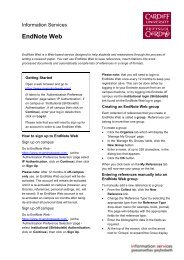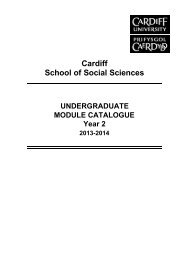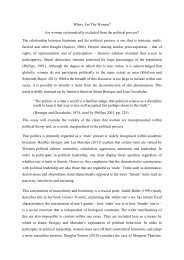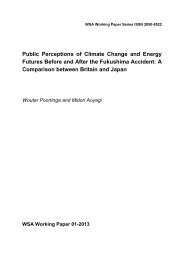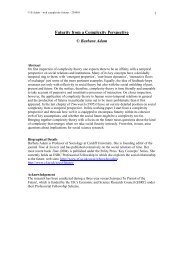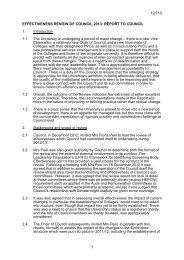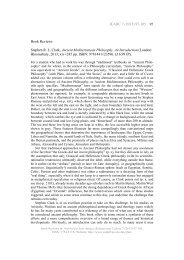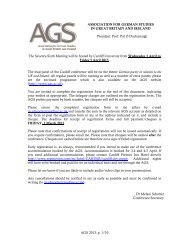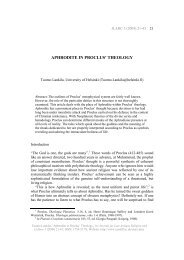Tina Askanius - Cardiff University
Tina Askanius - Cardiff University
Tina Askanius - Cardiff University
Create successful ePaper yourself
Turn your PDF publications into a flip-book with our unique Google optimized e-Paper software.
of the 1960s and 1970s, which<br />
documented the political activism of civil<br />
rights, anti-colonialism, anti-war protests,<br />
women and gay liberation movements<br />
(Boyle 1997; Juhasz 1995). Since the<br />
1970s a great deal of theoretical work,<br />
as well as filmmaking practice on the<br />
Left, has been devoted to developing and<br />
analysing ‘a revolutionary aesthetics – a<br />
combative form that poses the right<br />
questions in the intellectual struggle<br />
against capitalism’ (Gaines 1999: 232).<br />
Throughout the 1980s and 1990s antisystemic<br />
and critical voices continued to<br />
tap into the possibilities offered by video<br />
as the equipment and editing tools<br />
slowly became better and cheaper.<br />
Important examples of such upsurges in<br />
politically motivated video and television<br />
production include the bulk of alternative<br />
public access television projects<br />
launched in the early 1980s, also known<br />
as the guerrilla television movement (see<br />
e.g., Boyle 1997; Halleck 2005; Kellner<br />
1990; Stein 2001) or the anti-roads<br />
movement in Britain (Harding 2001),<br />
which used video to combine<br />
environmental activism with anticapitalist<br />
critique and critical<br />
perspectives on sustainable development<br />
– concerns that run into the global<br />
climate change activism that so urgently<br />
demands our attention today.<br />
The 2008 meltdown of financial markets<br />
provoked an upsurge in subversive video<br />
work and a renewed incitement to<br />
contest global capitalism and the<br />
increasing hegemony of market values in<br />
all aspects of governance in liberal<br />
democracies. But we need to go back<br />
another decade to the first countersummits<br />
and mass-demonstrations of<br />
the alter-globalisation movement against<br />
corporate power and financial<br />
globalisation in the late 1990s to fully<br />
understand the trajectory of<br />
contemporary protest politics. Largescale<br />
demonstrations against the<br />
institutions and symbols of global<br />
capitalism and the efforts to<br />
contemplate, mobilise for, document and<br />
raise awareness of these decentralised,<br />
but ‘spectacular’ protest events were part<br />
of what brought about the rapid growth<br />
of video activism in the late 1990s<br />
(Harding 2001). These political issues<br />
rose to the broader public agenda right<br />
around the time of the shift from<br />
analogue to digital video. The threshold<br />
of storage, processing capacity, and<br />
bandwidth we crossed in the mid-2000s,<br />
not only opened up new possibilities for<br />
dedicated ‘vidders’ and radical<br />
documentary makers but also catapulted<br />
political video into mainstream<br />
consciousness and everyday media<br />
practices (Russo and Coppa 2012).<br />
In the past decade, the struggle to<br />
contest neoliberalism and expose its<br />
consequences has been enacted in<br />
video production and theory, and<br />
inspired a large body of video work<br />
questioning the structure of institutions<br />
such as G8/20, The IMF, the WTO,<br />
corporate power, the politics of third<br />
world debt and the uneven distribution<br />
of power and resources in the process of<br />
financial globalisation. The waves of<br />
protests that currently face liberal<br />
democracies in the wake of the<br />
implosion of global markets grow out of<br />
this same matrix and a systemic critique<br />
similar to that of the alter-globalisation<br />
movement are raised today by the 15-M<br />
Indignados, the Occupy movement and<br />
the widespread austerity mobilisations<br />
across Europe. Although these<br />
movements have very different compositions,<br />
strategies and to some extent<br />
political orientations, they are united by<br />
how they contest the neoliberal<br />
mechanism by which all aspects of<br />
political and social organisation are<br />
increasingly based around the primacy<br />
4 <br />
www.cf.ac.uk/JOMECjournal<br />
@JOMECjournal



